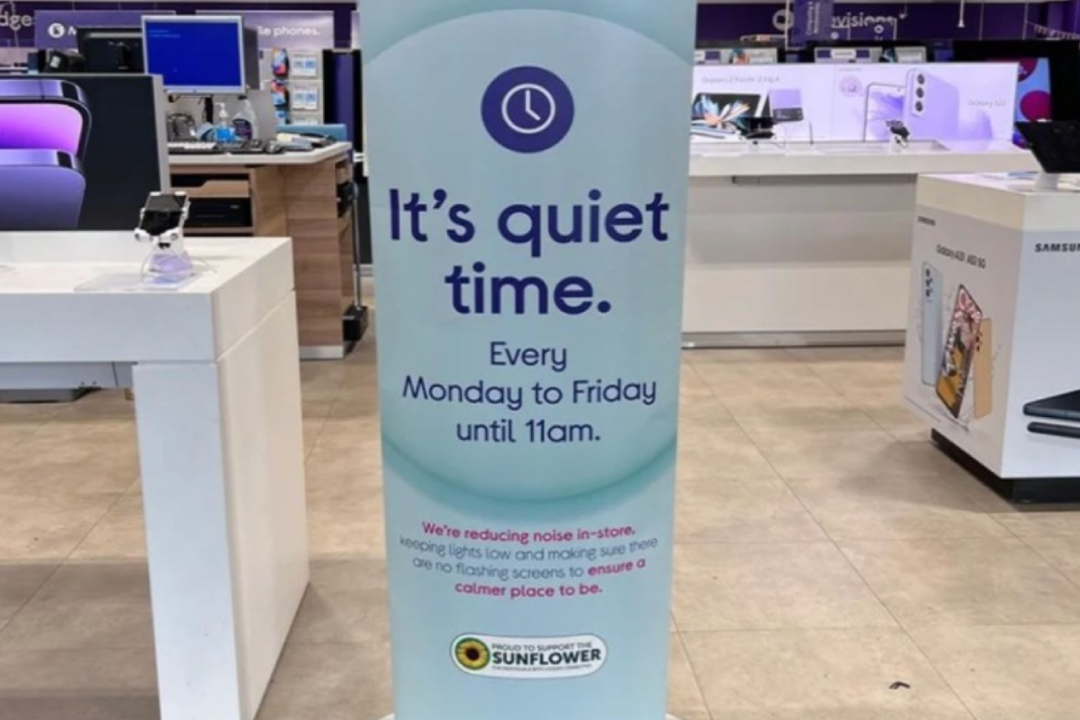
07 Feb How an electronics retailer is doing Quiet Hour differently
Image description: A banner at the entrance toa Curry’s store reads “Its Quiet Time every Monday to Friday until 11am”. Underneath the text there is an image of the Hidden Disabilities Sunflower logo.
Ainsley Sykes is Head of Commercial Initiatives, Retail Design & Technology at Currys, an electronic goods retailer in the UK. Ainsley also leads Curry’s local Diversity and Inclusion network.
Currys recently launched a Quiet Hour in its 300+ stores nationally, inspired by a staff member’s comment on the lack of accessibility in Curry’s stores for a sensory-sensitive family member. With the Exec team behind him, a test and learn approach was developed and a small group of stores trialled Quiet Hour.
So, what makes Curry’s Quiet Hour different to other retail Quiet Hour initiatives and what are the customer benefits that convinced leaders to move from trial to a full network rollout?
What makes Curry’s Quiet Hour different to other retail Quiet Hour initiatives?
Curry’s bring their products to life with sound, demonstrations, and visuals. Quiet Hour reduces sound and visual activity – contrary to the ingrained selling behaviour of electronics retailing.
With the help of We Are Purple and the Hidden Disability Sunflower organisation, Curry’s crafted a trial during which stores turned off their product ‘bells and whistles’ for an hour every day between Monday and Friday. The trial also involved the activation of sensory maps and offering customers a Hidden Disability Sunflower lanyard to enhance their experience. After trialling the service for several months, Curry’s is now the first electronics retailer in the UK to offer this service – every business day.
Customer and Colleague Feedback
Positive feedback was received from Curry’s Colleagues (store assistants) and customers throughout the trial. Neurodivergent Colleagues were very proud of the initiative and customer feedback was also positive, most surprisingly from the wider customer segment who commented how nice it was to come into a store that was quiet.
Not surprisingly, strong feedback was received from within the neurodivergent community and their carers.
Ainsley fondly tells the story of one customer, the parent of a neurodivergent child, who could test the noise a vacuum cleaner made in the quiet store before purchasing the cleaner. As a result, she was able to purchase a product with confidence that it would be the right choice for her home, avoid a product return and most importantly, accommodate the needs of her sensory-sensitive child.
Business As Usual…
Quiet Hour is now a part of the Curry’s customer experience offer. The team recognises that while Quiet Hour operates for an hour a day, sensory needs are every hour of every day. Sensory maps are active during all business hours and the Sunflower lanyard is also an everyday staple at the front of store, so that customers can receive the service they need at any time of any day. Curry’s Colleagues are continuing to take on feedback and the leadership team will evolve the offer, balancing Customer needs and operational requirements of store formats and traffic volume.
Ainsley and his executive team believe their Quiet Hour is an investment in brand love and in their customers through creating more inclusive and accessible customer experiences.
It’s encouraging to see more retailers exploring the needs of their neurodivergent customers. I look forward to watching how Curry’s Quiet Hour initiative evolves.


